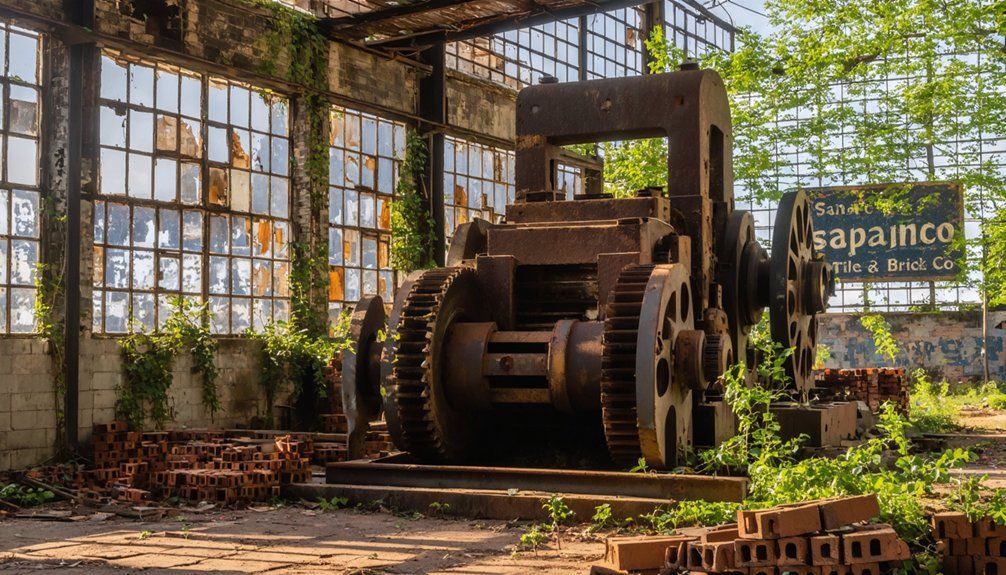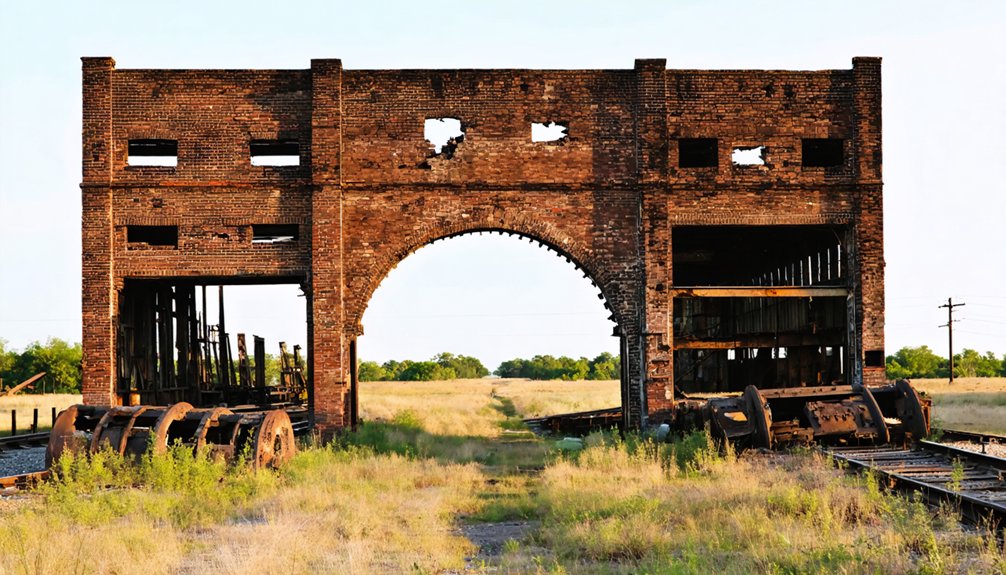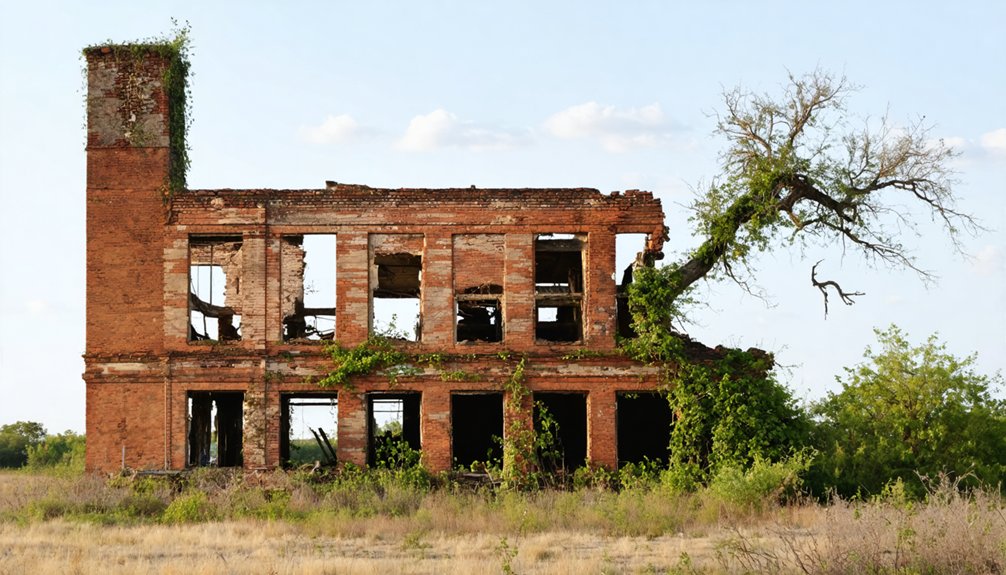You’ll find Saspamco’s ghostly remains along the San Antonio River, where the San Antonio Sewer Pipe Manufacturing Company once produced 120 tons of sewer pipe daily. Founded in 1901, this industrial powerhouse employed 150 workers, mostly Mexican immigrants, and spawned a thriving community of 443 residents by 1990. Today, only Our Lady of Perpetual Help Church stands as a sentinel among abandoned kilns, while countless untold stories echo through its checkered brick facades.
Key Takeaways
- Saspamco was established in 1901 as San Antonio Sewer Pipe Manufacturing Company, producing 120 tons of sewer pipe daily.
- The town thrived from 1900s to 1930s with 150 workers, grocery stores, churches, hotels, and a cotton gin.
- Mexican immigrant laborers formed the backbone of Saspamco’s workforce, creating a strong cultural community around Our Lady of Perpetual Help.
- Economic decline began in the mid-1960s, leading to business closures and workforce dispersal as the pipe plant downsized.
- By 1990, Saspamco had transformed into a ghost town with only one business remaining and 443 residents.
The Birth of a Manufacturing Hub
While many Texas towns sprouted from cattle ranches or oil discoveries, Saspamco emerged from the rich red clay beneath its soil. In 1901, you’d have witnessed the birth of the San Antonio Sewer Pipe Manufacturing Company, which would establish the town’s economic roots and manufacturing legacy for generations to come.
The company’s strategic location on the northern bank of the San Antonio River, combined with the San Antonio and Aransas Pass Railway’s loading switch, created the perfect conditions for industrial growth. The facility relied heavily on red potters clay to enhance their production quality and expand their product line. Early workforce demographics show that Mexican immigrant laborers formed the majority of the town’s population.
You’ll find the town’s very name reflects its industrial heritage – SASPAMCO – drawn from the company that transformed this slice of Texas into a bustling manufacturing hub. With the opening of a post office that same year, the foundation was laid for a thriving community.
Rise of the Mexican-American Community
As Mexican immigrants arrived in Saspamco seeking opportunities at the San Antonio Sewer Pipe Manufacturing Company in 1901, they formed the backbone of the town’s industrial workforce and established a vibrant cultural community.
You’ll find that these workers, primarily from Coahuila and Nuevo León, demonstrated remarkable community resilience as they built their lives around the demanding work at the pipe plant.
Despite facing harsh conditions and discrimination, they created strong social networks centered around their Catholic church, which served as both a spiritual haven and community hub.
In the face of adversity, Mexican immigrants found strength and unity through their church, building lasting bonds within their community.
Their cultural identity flourished through mutual aid societies and cultural organizations, helping preserve their Mexican heritage while adapting to life in Texas. In 1923, they built Our Lady of Perpetual Help church using materials from their own community, symbolizing their dedication to establishing permanent roots in Saspamco.
Our Lady of Perpetual Help: A Spiritual Cornerstone
You’ll find the heart of Saspamco’s spiritual life in Our Lady of Perpetual Help Catholic Church, established in 1923 through the generous land donation of Lorenzo and Victoria Gonzales.
The church’s construction embodied true community spirit, with local laborers using materials from the Gonzales sand pit and well water to build their sacred gathering place. In 1969, Father Pedro Parra supervised a significant remodeling project of the church and hall. The color photograph captured in 2004 showcases the church’s distinctive exterior architecture.
Since its first Mass in 1924, this cherished landmark has served as the cornerstone of religious life for generations of Mexican-American families, hosting countless baptisms, weddings, and traditional celebrations like the Virgen de Guadalupe festivities.
Community’s Sacred Gathering Place
Since 1923, Our Lady of Perpetual Help has stood as the spiritual cornerstone of Saspamco’s primarily Hispanic community. Built with local materials from the Gonzales sand pit and well, this Roman-Rite Catholic Church quickly became the heart of local sacred rituals and community gatherings.
You’ll find the church bustling with activity throughout the year, from traditional baptisms and weddings to vibrant Virgen de Guadalupe celebrations and Christmas pageants. Operating under the Metropolitan Archdiocese of San Antonio, the church maintains strong ties with neighboring Catholic parishes.
In 1955, local women established an altar society, while Father Pedro Parra led significant renovations in 1969, adding a new hall to accommodate the growing congregation.
The church continues to preserve Hispanic cultural traditions while fostering fellowship through its educational programs and annual festivals, serving as both a spiritual haven and historical landmark for Saspamco’s faithful.
Built Through Local Unity
When Lorenzo and Victoria Gonzales donated land for a new church in 1923, they sparked a remarkable display of community solidarity in Saspamco.
The construction of Our Lady of Perpetual Help Church showcased the power of local resources and community involvement, with residents taking control of their spiritual destiny.
You’ll find evidence of their unified spirit in these key aspects:
- Sand and gravel came directly from the Gonzales family pit
- Construction water was drawn from their own community well
- Local Mexican immigrant laborers built the entire structure
- No outside contractors were needed – just dedicated townspeople
This grassroots effort continued through the decades, from Bishop Drossaerts’ first mass in 1924 to Father Parra’s 1969 expansions, proving that when people work together, they can create lasting monuments to their faith and determination.
Enduring Religious Heritage
The construction of Our Lady of Perpetual Help Church marked the beginning of a profound spiritual legacy in Saspamco that extends far beyond its physical walls.
You’ll find evidence of religious resilience in the church’s vibrant traditions, from the annual Virgen de Guadalupe celebrations to the moving Passion of Christ productions that have united generations of faithful.
Since 1924, the church has served as more than just a place of worship.
Through the dedicated work of its Altar Society and continuous community support, it’s preserved Mexican Catholic traditions while adapting to changing times.
Even as Saspamco transformed into a ghost town, this spiritual cornerstone has remained steadfast in its cultural preservation, offering baptisms, weddings, and religious education that keep the Hispanic community’s faith and heritage alive.
Industrial Peak and Economic Growth

You’ll find Saspamco’s most prosperous period centered around its pipe manufacturing operations in the early 1900s through the 1930s.
The San Antonio Sewer Pipe Manufacturing Company employed about 150 workers at its peak, churning out an impressive 120 tons of sewer pipe daily to supply San Antonio’s growing infrastructure needs. By 1915, the growing industrial settlement had reached a population of 125 residents.
The factory’s success attracted Mexican immigrant laborers and spurred the development of local businesses, including three grocers, two general stores, a hotel, and a cotton gin that served the expanding community. Located on the northern bank of the San Antonio River, the town’s strategic position facilitated industrial operations and transportation.
Manufacturing Growth Period
During Saspamco’s industrial peak, San Antonio Sewer Pipe Manufacturing Company emerged as a powerhouse of production, churning out an impressive 120 tons of sewer pipe daily by the late 1930s.
The factory’s distinctive checkered brick facade stood as an architectural testament to its industrial prominence in the region. You’ll find manufacturing innovations were key to the company’s economic sustainability, from its strategic location on the San Antonio River to its efficient rail system for shipping finished goods.
- On-site clay extraction and sand mining operations kept raw materials flowing
- Shift from cordwood to lignite fuel doubled thermal efficiency
- Custom rail spurs connected directly to massive kilns for streamlined loading
- Company store and housing system maintained a stable 150-worker labor force
The facility’s self-contained operation transformed the region into a bustling industrial hub, complete with grocery stores, churches, a cotton gin, and hotels by 1915.
Labor and Market Success
Building upon its manufacturing momentum, Saspamco’s labor market thrived as a demonstration of industrial success in rural Texas.
You’ll find the pipe plant employed 150 workers during its peak in the late 1930s – a remarkable figure considering the town’s population of just 200. These labor dynamics created a robust economic ecosystem where ancillary businesses flourished, including grocers, a hotel, and a dairy.
The plant’s impressive daily output of 120 tons of sewer pipe anchored the local economy, while market fluctuations remained manageable due to steady industrial demand.
Cultural Heritage and Social Life
As workers from Mexico settled in Saspamco around 1901, they forged a vibrant cultural community centered on faith, family, and shared immigrant experiences.
You’ll find their cultural preservation efforts most evident in Our Lady of Perpetual Help Catholic Church, built by the laborers themselves in 1923, which became the heart of community resilience.
- Annual festivals and celebrations honored both Catholic and Mexican traditions
- The Ladies’ Altar Society organized fundraising dinners that brought everyone together
- Traditional events like Virgen de Guadalupe celebrations maintained cultural bonds
- Local businesses and the church hall provided gathering spaces for social life
Even as Saspamco’s population declined, these cultural traditions endured, weaving together faith, labor, and heritage in ways that defined this unique Texas community.
The Quiet Transformation to Ghost Town Status

While Saspamco once thrived as a bustling industrial hub producing 120 tons of sewer pipe daily, its transformation into a ghost town unfolded gradually through the latter half of the 20th century.
You can trace the economic decline through the mid-1960s when businesses began closing their doors despite a modest population increase. By 1990, just one business remained operational, even as the population reached 443 residents.
The town’s workforce dispersed as the pipe plant – once employing 150 workers – downsized and eventually shuttered. Population stagnation set in by 2000, and the town’s commercial infrastructure virtually disappeared.
What you’ll find today is a quiet reminder of a once-vibrant community that succumbed to changing economic tides and the consolidation of services in larger urban centers.
Frequently Asked Questions
What Natural Disasters or Significant Events Contributed to Saspamco’s Decline?
You won’t find direct hurricane impact on Saspamco’s decline, though Texas coastal towns faced storms. Instead, the economic downturn from shifting industrial needs and declining railway importance sealed its fate.
Are There Any Preserved Artifacts From the Sewer Pipe Factory?
Like fragments of time frozen in clay, you’ll find three photographs from 1914-1915 showing the factory’s brick architecture, while postcards and historical records document the sewer artifacts’ enduring significance.
What Happened to the Families Who Lived There After Closure?
You’ll find many families relocated to Floresville or San Antonio for jobs, while others stayed connected through OLPH Catholic Church. The community impact split between those seeking opportunities elsewhere and maintaining local roots.
Can Visitors Legally Explore the Remaining Structures in Saspamco Today?
You can’t legally enter structures without property owner permission due to ghost town regulations and legal restrictions. Your best option is viewing from public roads or getting explicit landowner consent.
Did Any Other Industries Attempt to Establish Themselves in Saspamco?
You won’t find evidence of significant industrial ventures beyond the pipe factory, though there were small-scale agricultural developments like peanut farming and cattle grazing. No mining attempts or other major industries materialized.
References
- https://www.wilsoncountyhistory.org/talk-saspamco
- https://www.tshaonline.org/handbook/entries/saspamco-tx
- https://www.ksat.com/holidays/2018/10/30/texas-has-more-ghost-towns-than-any-other-state/
- https://texashighways.com/travel-news/four-texas-ghost-towns/
- https://en.wikipedia.org/wiki/List_of_ghost_towns_in_Texas
- https://www.wilsoncountyhistory.org/pg-saspamco
- https://en.wikipedia.org/wiki/Saspamco
- https://www.texasescapes.com/SouthTexasTowns/Saspamco-Texas.htm
- https://texashistory.unt.edu/ark:/67531/metapth129921/
- https://losttexasroads.com/history/people/mackey-nelson/



